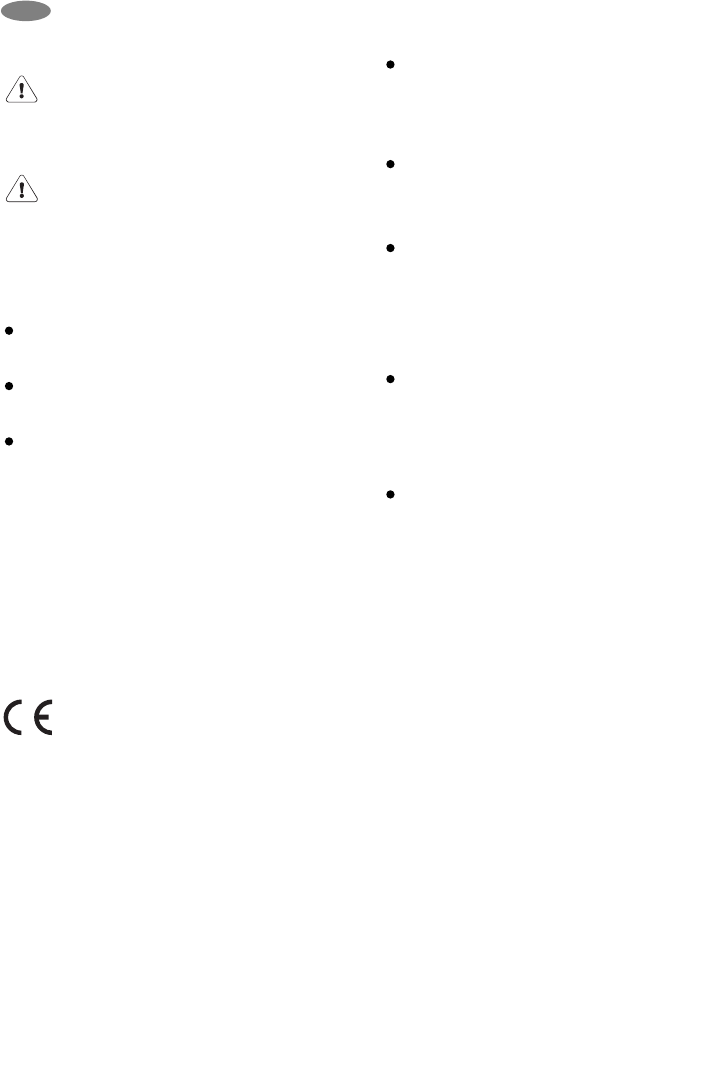
10
GB
Upon completion there must be no cut, or stray strands
of wire present and the cord clamp must be secure over
the outer sheath.
Important! The plug must still be accessible after
the appliance has been installed. The appliance
should not be connected to the electrical supply by
means of an extension cable. In case that the electrical
cable has to be replaced, please contact your local Service
Force Centre.
Warning! A cut off plug inserted into a 13 amp
socket is a serious safety (shock) hazard. Ensure
that it is disposed of safely.
Noises During Operation
The following noises are characteristic of refrigeration
appliances:
Clicks
Whenever the compressor switches on or off, a click can
be heard.
Humming
As soon as the compressor is in operation, you can hear
it humming.
Bubbling/Splashing
When refrigerant flows into thin tubes, you can hear
bubbling or splashing noises. Even after the compressor
has been switched off, this noise can be heard for a
short time.
Regulations, Standards, Guidelines
This appliance was designed for household use and was
manufactured in accordance with the appropriate
standards. The necessary measures in accordance with
appliance safety legislation regulations (GSG), accident
prevention regulations for refrigeration appliances (VBG 20)
and the regulations of the German Society of Electrical
Engineers (VDE) were observed in the manufacture of this
appliance. The refrigerant circuit has been checked for leaks.
This appliance is in accordance with the following
EUguidelines:
– 73/23/EWG dated 19 February 1973 - low voltage
guidelines.
– 89/336/EWG dated 3 May 1989
(including guideline change notice 92/31/EWG) - EMV
guideline
– 96/57 EEC - 96/09/03 (Energy Efficiency Directive) and its
subsequent amendments
Technical Terminology
Refrigerant
Liquids that can be used to a generate a cooling
effect are known as refrigerants. They have a
relatively low boiling-point, indeed so low, that the
warmth from the food stored in the fridge or freezer
can cause the refrigerant to boil and vaporise.
Refrigerant Circuit
Closed circulation system that contains the
refrigerant. The refrigerant circuit comprises
primarily of an evaporator, a compressor, a
condenser and pipe work.
Evaporator
The refrigerant is evaporated in the evaporator.
Similar to all other liquids, refrigerant requires heat
to evaporate. This heat is removed from the interior
of the appliance, as a result the interior is cooled.
The evaporator is therefore located inside the
appliance or placed in foam immediately behind the
inner wall and thus not visible.
Compressor
The compressor looks like a small drum. It is driven
by a built-in electric motor and is mounted on the
base of the appliance at the rear. The task of the
compressor is to draw in vaporised refrigerant from
the evaporator, to compress it, and to pass it on to
the condenser.
Condenser
The condenser normally has the form of a grid. The
refrigerant com-pressed in the compressor is
liquefied in the condenser. During this process, heat
is released to the surrounding air at the surface of
the condenser. The condenser is mounted on the
base of the appliance.
A/AE/4-2. (08.)














